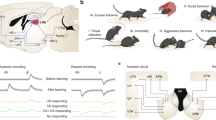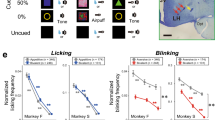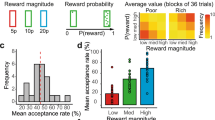Abstract
An action may lead to either a reward or a punishment. Therefore, an appropriate action needs to be chosen on the basis of the values of both expected rewards and expected punishments. To understand the underlying neural mechanisms, we conditioned monkeys using a Pavlovian procedure with two distinct contexts: one in which rewards were available and another in which punishments were feared. We found that the population of lateral habenula neurons was most strongly excited by a conditioned stimulus associated with the most unpleasant event in each context: the absence of the reward or the presence of the punishment. The population of lateral habenula neurons was also excited by the punishment itself and inhibited by the reward itself, especially when they were less predictable. These results suggest that the lateral habenula has the potential to adaptively control both reward-seeking and punishment-avoidance behaviors, presumably through its projections to dopaminergic and serotonergic systems.
This is a preview of subscription content, access via your institution
Access options
Subscribe to this journal
Receive 12 print issues and online access
$209.00 per year
only $17.42 per issue
Buy this article
- Purchase on Springer Link
- Instant access to full article PDF
Prices may be subject to local taxes which are calculated during checkout








Similar content being viewed by others
References
Delgado, M.R., Nystrom, L.E., Fissell, C., Noll, D.C. & Fiez, J.A. Tracking the hemodynamic responses to reward and punishment in the striatum. J. Neurophysiol. 84, 3072–3077 (2000).
O'Doherty, J., Kringelbach, M.L., Rolls, E.T., Hornak, J. & Andrews, C. Abstract reward and punishment representations in the human orbitofrontal cortex. Nat. Neurosci. 4, 95–102 (2001).
Breiter, H.C., Aharon, I., Kahneman, D., Dale, A. & Shizgal, P. Functional imaging of neural responses to expectancy and experience of monetary gains and losses. Neuron 30, 619–639 (2001).
Nieuwenhuis, S. et al. Activity in human reward-sensitive brain areas is strongly context dependent. Neuroimage 25, 1302–1309 (2005).
Tobler, P.N., Fiorillo, C.D. & Schultz, W. Adaptive coding of reward value by dopamine neurons. Science 307, 1642–1645 (2005).
Sugrue, L.P., Corrado, G.S. & Newsome, W.T. Matching behavior and the representation of value in the parietal cortex. Science 304, 1782–1787 (2004).
Paton, J.J., Belova, M.A., Morrison, S.E. & Salzman, C.D. The primate amygdala represents the positive and negative value of visual stimuli during learning. Nature 439, 865–870 (2006).
Padoa-Schioppa, C. & Assad, J.A. Neurons in the orbitofrontal cortex encode economic value. Nature 441, 223–226 (2006).
Samejima, K., Ueda, Y., Doya, K. & Kimura, M. Representation of action-specific reward values in the striatum. Science 310, 1337–1340 (2005).
Sallet, J. et al. Expectations, gains and losses in the anterior cingulate cortex. Cogn. Affect. Behav. Neurosci. 7, 327–336 (2007).
Lau, B. & Glimcher, P.W. Value representations in the primate striatum during matching behavior. Neuron 58, 451–463 (2008).
Mirenowicz, J. & Schultz, W. Preferential activation of midbrain dopamine neurons by appetitive rather than aversive stimuli. Nature 379, 449–451 (1996).
Yamada, H., Matsumoto, N. & Kimura, M. Tonically active neurons in the primate caudate nucleus and putamen differentially encode instructed motivational outcomes of action. J. Neurosci. 24, 3500–3510 (2004).
Kobayashi, S. et al. Influences of rewarding and aversive outcomes on activity in macaque lateral prefrontal cortex. Neuron 51, 861–870 (2006).
Herkenham, M. & Nauta, W.J. Afferent connections of the habenular nuclei in the rat. A horseradish peroxidase study, with a note on the fiber-of-passage problem. J. Comp. Neurol. 173, 123–146 (1977).
Parent, A., Gravel, S. & Boucher, R. The origin of forebrain afferents to the habenula in rat, cat and monkey. Brain Res. Bull. 6, 23–38 (1981).
Herkenham, M. & Nauta, W.J. Efferent connections of the habenular nuclei in the rat. J. Comp. Neurol. 187, 19–47 (1979).
Wise, R.A. Dopamine, learning and motivation. Nat. Rev. Neurosci. 5, 483–494 (2004).
Hikosaka, O., Nakamura, K. & Nakahara, H. Basal ganglia orient eyes to reward. J. Neurophysiol. 95, 567–584 (2006).
Cools, R., Roberts, A.C. & Robbins, T.W. Serotoninergic regulation of emotional and behavioral control processes. Trends Cogn. Sci. 12, 31–40 (2008).
Christoph, G.R., Leonzio, R.J. & Wilcox, K.S. Stimulation of the lateral habenula inhibits dopamine-containing neurons in the substantia nigra and ventral tegmental area of the rat. J. Neurosci. 6, 613–619 (1986).
Ji, H. & Shepard, P.D. Lateral habenula stimulation inhibits rat midbrain dopamine neurons through a GABA(A) receptor–mediated mechanism. J. Neurosci. 27, 6923–6930 (2007).
Wang, R.Y. & Aghajanian, G.K. Physiological evidence for habenula as major link between forebrain and midbrain raphe. Science 197, 89–91 (1977).
Sutherland, R.J. The dorsal diencephalic conduction system: a review of the anatomy and functions of the habenular complex. Neurosci. Biobehav. Rev. 6, 1–13 (1982).
Lecourtier, L. & Kelly, P.H. A conductor hidden in the orchestra? Role of the habenular complex in monoamine transmission and cognition. Neurosci. Biobehav. Rev. 31, 658–672 (2007).
Matsumoto, M. & Hikosaka, O. Lateral habenula as a source of negative reward signals in dopamine neurons. Nature 447, 1111–1115 (2007).
Glimcher, P.W. Indeterminacy in brain and behavior. Annu. Rev. Psychol. 56, 25–56 (2005).
Solomon, R.L. & Corbit, J.D. An opponent-process theory of motivation. I. Temporal dynamics of affect. Psychol. Rev. 81, 119–145 (1974).
Seymour, B., Singer, T. & Dolan, R. The neurobiology of punishment. Nat. Rev. Neurosci. 8, 300–311 (2007).
Schultz, W. & Dickinson, A. Neuronal coding of prediction errors. Annu. Rev. Neurosci. 23, 473–500 (2000).
Schultz, W. Predictive reward signal of dopamine neurons. J. Neurophysiol. 80, 1–27 (1998).
Nakahara, H., Itoh, H., Kawagoe, R., Takikawa, Y. & Hikosaka, O. Dopamine neurons can represent context-dependent prediction error. Neuron 41, 269–280 (2004).
Belova, M.A., Paton, J.J., Morrison, S.E. & Salzman, C.D. Expectation modulates neural responses to pleasant and aversive stimuli in primate amygdala. Neuron 55, 970–984 (2007).
Schultz, W., Dayan, P. & Montague, P.R. A neural substrate of prediction and reward. Science 275, 1593–1599 (1997).
Montague, P.R., Dayan, P. & Sejnowski, T.J. A framework for mesencephalic dopamine systems based on predictive Hebbian learning. J. Neurosci. 16, 1936–1947 (1996).
Doya, K. Metalearning and neuromodulation. Neural Netw. 15, 495–506 (2002).
Lecourtier, L., Defrancesco, A. & Moghaddam, B. Differential tonic influence of lateral habenula on prefrontal cortex and nucleus accumbens dopamine release. Eur. J. Neurosci. 27, 1755–1762 (2008).
Yang, L.M., Hu, B., Xia, Y.H., Zhang, B.L. & Zhao, H. Lateral habenula lesions improve the behavioral response in depressed rats via increasing the serotonin level in dorsal raphe nucleus. Behav. Brain Res. 188, 84–90 (2008).
Nakamura, K., Matsumoto, M. & Hikosaka, O. Reward-dependent modulation of neuronal activity in the primate dorsal raphe nucleus. J. Neurosci. 28, 5331–5343 (2008).
Gandhi, N.J. & Bonadonna, D.K. Temporal interactions of air-puff–evoked blinks and saccadic eye movements: insights into motor preparation. J. Neurophysiol. 93, 1718–1729 (2005).
Acknowledgements
We thank S. Hong, M. Yasuda and E. Bromberg-Martin for valuable discussion, and M.K. Smith, J.W. McClurkin, A.M. Nichols, T.W. Ruffner, A.V. Hays and L.P. Jensen for technical assistance. This research was supported by the Intramural Research Program at the National Institutes of Health, National Eye Institute.
Author information
Authors and Affiliations
Contributions
M.M. designed the Pavlovian procedure, performed the experiments and analyzed the data. O.H. supported all of these processes. M.M. and O.H. discussed the results and wrote the manuscript.
Corresponding author
Supplementary information
Supplementary Text and Figures
Supplementary Figures 1–6 and Supplementary Note (PDF 612 kb)
Rights and permissions
About this article
Cite this article
Matsumoto, M., Hikosaka, O. Representation of negative motivational value in the primate lateral habenula. Nat Neurosci 12, 77–84 (2009). https://doi.org/10.1038/nn.2233
Received:
Accepted:
Published:
Issue Date:
DOI: https://doi.org/10.1038/nn.2233
This article is cited by
-
A neural mechanism for conserved value computations integrating information and rewards
Nature Neuroscience (2024)
-
Unraveling the serotonin saga: from discovery to weight regulation and beyond - a comprehensive scientific review
Cell & Bioscience (2023)
-
Plasticity of synapses and reward circuit function in the genesis and treatment of depression
Neuropsychopharmacology (2023)
-
Plasticity of neuronal dynamics in the lateral habenula for cue-punishment associative learning
Molecular Psychiatry (2023)
-
Rewarding-unrewarding prediction signals under a bivalent context in the primate lateral hypothalamus
Scientific Reports (2023)



